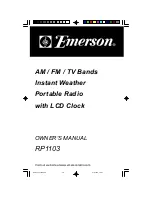
P a g e
| 26
If the Weather Center is moved to another location significantly higher or lower than its
initial standing point (for example from the ground floor to the upper floors of a house),
discard the weather forecast for the next 48-60 hours, as the Weather Center may
mistake the new location as being a possible change in air-pressure when really it is
due to the slight change of altitude.
WEATHER TENDENCY INDICATOR
Working together with the weather icons is the weather tendency indicators (arrow
located on the left and right sides of the weather icons). When the indicator points
upwards, it means that the air-pressure is increasing and the weather is expected to
improve, but when indicator points downwards, the air-pressure is dropping and the
weather is expected to become worse.
Taking this into account, one can see how the weather has changed and is expected to
change. For example, if the indicator is pointing downwards together with cloud and sun
icons, then the last noticeable change in the weather was when it was sunny (the sun
icon only). Therefore, the next change in the weather will be cloud with rain icons since
the indicator is pointing downwards.
Note:
Once the weather tendency indicator has registered a change in air pressure,
it will remain permanently visualized on the LCD.
AIR PRESSURE HISTORY (ELECTRONIC BAROMETER WITH BAROMETRIC PRESSURE
TREND)
The LCD also shows the relative air pressure value and the air pressure history.
Press the SET key to toggle between Mode1 and Mode2 of the display.
In Mode 1, the bar graph of the electronic barometer shows the air pressure history of
the past 24 hours in seven steps.
In Mode 2, the bar graph of the electronic barometer shows the air pressure history of
the past 72 hours in seven steps.
In Mode 1, the horizontal axis represents the last 24 hours of air pressure recording (-24,
-18, -12, -8, -6, -3 and 0 hour).
In Mode 2, the horizontal axis represents the last 72 hours of air pressure recording (-72,
-48, -36, -24, -12, -6 and 0 hour).









































